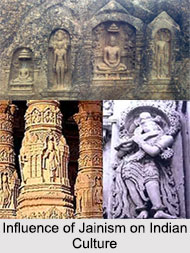 Influence of Jainism on Indian culture has been on all aspects. Language and Literature, architecture, temples, sculpture, painting, philosophy have all been influenced by Jainism. It brought changes in the religious atmosphere of India. By its contribution it enriched the Indian Culture. It cast its shadow over many aspects of Indian Culture.
Influence of Jainism on Indian culture has been on all aspects. Language and Literature, architecture, temples, sculpture, painting, philosophy have all been influenced by Jainism. It brought changes in the religious atmosphere of India. By its contribution it enriched the Indian Culture. It cast its shadow over many aspects of Indian Culture.
Influence of Jainism on Language and Literature
The Sramana culture is represented by the Jains and the Buddhists. Jains had propagated this culture in the beginning. Sramana literature disregards the caste system. The subjects of poetry are popular tales, fairy stories, fables and parables; insists on the sufferings of samsara. The authors of Sramana literature have contributed to the religious, ethical, poetical, and scientific literature of ancient India. The Jains composed various kinds of narrative literature like puranas, charitras, kathas, prabandhas and so on. Jain poets have also Kavyas and mahakavyas, lyrical and didactic poetry.
They have also contributed to the Indian scientific and technical literature on various subjects like logic, philosophy, poetics, grammar, lexicography, astronomy, astrology, geography, mathematics and medicine.
Influence of Jainism on Architecture
Jain had no special architecture. They adopted the local building traditions. In North India, they followed the Vaishnava cult and in South India, they followed the Dravidian format. One cannot distinguish the Jain style of architecture. They have constructed sacred buildings like temples, temple cities, cave temples, stupas, pillars and towers. They have constructed several temples throughout India. The two marble temples at Mount Abu in Rajasthan are most notable ones.
There are several cave temples built by the Jains. The well known are Udayagiri and Khandagiri Hills in Odisha. They have also erected stupas and well known ones are in the Kankali mound near Mathura in Uttar Pradesh.
 Influence of Jainism on Sculpture
Influence of Jainism on Sculpture
Along with literature the Jains have always contributed considerably to the development of the arts in the country. The most common form of sculpture is making statues of Jain Tirthankaras. There are images of all sizes. The most remarkable of the Jain statues are the ones at Shravanabelgola in Hassan District, at Karkala in South Karnataka District and at Yenura or Venura in South Kanara District.
Influence of Jainism on Philosophy
The Jains have developed a separate philosophy. Their doctrines are Nayavada, karma and Sayavada. The significance of this Jain theory of "Being" comes out clearly when it is regarded in relation to the doctrines of Syadvada and of Nayavada. According to Syadvada any metaphysical proposition is right from one point of view and its contrary is also right from another view point. Naya doctrine complements the logic of Syadvada.
One of the main principles of Jain is ahimsa. It forms the basis of various rules of conduct. Jains are known for the evolution of ahimsa culture and they practiced and propagated that culture since time immemorial.
Political Contribution of Jainism
Jains produced several eminent and efficient monarchs, ministers and generals. They created the proper political environment based on ahimsa culture. Jain ascetics were never indifferent towards the secular affairs. Jain saints were responsible for the foundation of the Ganga kingdom in the 2nd century A.D. and the Hoyasala kingdom in the 11th century A.D.
Thus, Jainism has played a very significant role in the development of language, philosophy, architecture, sculpture and painting in India. It never became a dominant religion, nor was it embraced by a large number of people, and it never crossed the frontiers of India; but its presence in Indian art and culture was always admired.




















